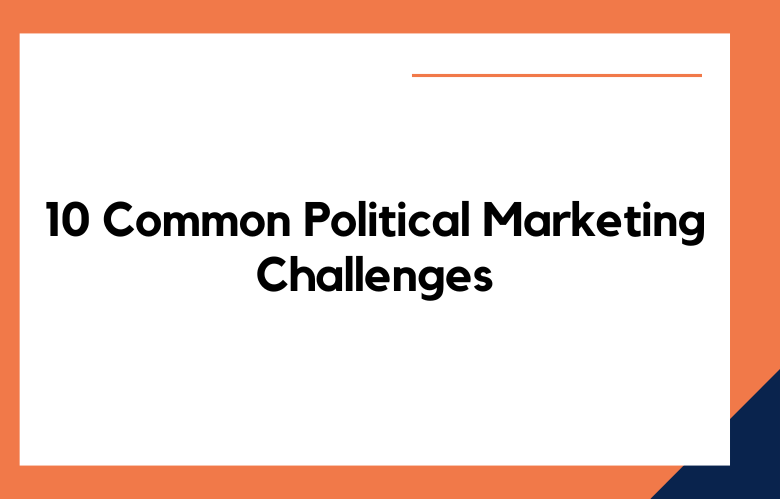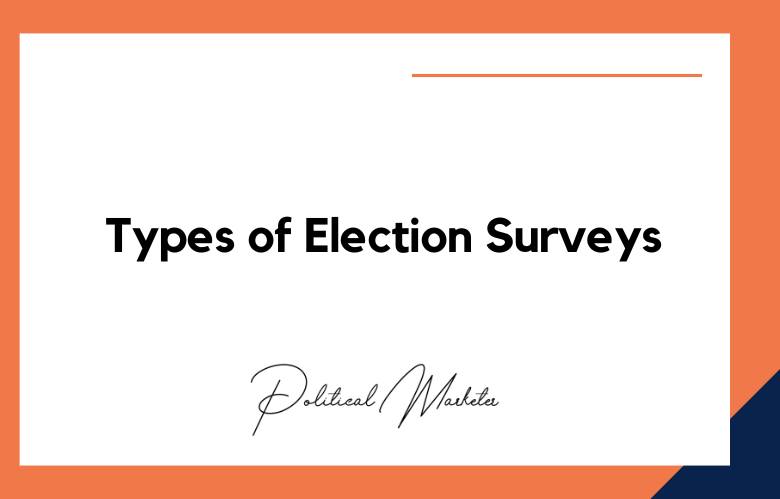Political marketing faces many challenges, each complicating the pathway to effectively reaching and persuading voters. Here are ten common challenges that political marketers often encounter.
Political marketing can be a minefield of challenges that require strategic thinking, creativity, and adaptability. From reaching a diverse audience to effectively addressing policy issues, marketing professionals must navigate a complex landscape to ensure their campaign’s success. This blog post explores ten common political marketing challenges and provides actionable insights to help you overcome them.
10 Common Political Marketing Challenges
Voter Saturation: In the digital age, voters are bombarded with constant information, making it increasingly difficult for any political message to stand out and make a lasting impact.
Evolving Media Consumption: As media consumption habits shift, particularly among younger demographics, campaigns must adapt to new platforms and technologies to reach their audience, which can be complex and costly.
Data Privacy Concerns: With growing awareness and regulation around data privacy, political marketers must navigate the fine line between personalized messaging and respecting individuals’ privacy rights, often limiting access to valuable voter information.
Misinformation and Trust: The proliferation of Misinformation on social media and other platforms has led to a general erosion of trust in political messaging, making it harder for authentic messages to be believed and acted upon.
Polarization and Echo Chambers: Increasing political polarization and the formation of echo chambers, particularly online, mean that messages often reach only those who already agree, making it challenging to persuade undecided or opposing voters.
Regulatory Compliance: Political campaigns must adhere to a complex web of regulations regarding funding, advertising, and data use that vary by country, state, and even locality, complicating campaign strategy execution.
Rapid News Cycles: The fast pace of news cycles can quickly render a well-planned campaign message irrelevant or off-target, requiring constant vigilance and the ability to pivot strategies immediately.
Cybersecurity Threats: The increasing threat of cyber attacks on campaign infrastructure, including data breaches and hacking, poses significant risks to both the integrity of the campaign and the safety of voter information.
Resource Allocation: Deciding where and how to allocate limited campaign resources across a diverse and fragmented media landscape while ensuring optimal impact remains a perennial challenge.
Measuring Impact: Quantifying the direct impact of political marketing efforts on voter behavior and election outcomes can be elusive, making it challenging to evaluate campaign effectiveness and adjust strategies accordingly.
These challenges underscore the complex and dynamic nature of political marketing, requiring campaigns to be innovative, agile, and ethically grounded to successfully navigate the intricate landscape of modern electoral politics.
Rise Above the Rest: Strategies for Conquering Political Marketing Challenges
Conquering political marketing challenges in today’s dynamic electoral environment demands innovation, strategic insight, and a deep understanding of voter behavior. Here are several strategies designed to help political campaigns rise above the rest:
Embrace Data-Driven Decision Making: Utilize advanced analytics and big data to gain insights into voter preferences, behaviors, and trends. Tailor your messaging and outreach efforts based on data-driven insights to maximize impact and efficiency.
Master Digital Engagement: In an era where digital platforms dominate communication, develop a robust online presence. Use social media, email campaigns, and digital ads to engage with voters directly, fostering a sense of community and personal connection.
Develop a Strong, Authentic Brand: Voters resonate with authenticity and consistency. Craft a compelling campaign narrative that reflects your core values and mission. Ensure that all communications reinforce your brand identity and message.
Segment and Personalize: Not all voters are the same. Segment your audience based on demographics, interests, and behaviors. Personalize your messaging to address different voter groups’ specific concerns and aspirations, making each feel uniquely understood.
Innovate with Technology: Stay ahead by adopting the latest technological advancements in your campaign strategy. From AI-driven targeting to VR campaign events, innovative tools can provide a competitive edge and captivate the electorate’s imagination.
Cultivate Grassroots Support: Ground-level engagement can amplify your campaign’s reach and authenticity. Invest in grassroots organizing to mobilize volunteers, conduct door-to-door campaigns, and organize community events, creating a solid foundation of support.
Counter Misinformation Effectively: Develop a proactive strategy to combat Misinformation. Establish a rapid response team and utilize fact-checking resources to maintain the integrity of your campaign and protect the electorate’s right to accurate information.
Breaking the Mold: Innovative Solutions for Political Marketing Hurdles
Breaking the mold in political marketing involves facing hurdles head-on and devising innovative solutions that redefine engagement and influence within the political landscape. As campaigns grapple with voter saturation, Misinformation, data privacy concerns, and the rapid evolution of media consumption habits, the need for creativity and innovation has never been more critical. Here’s how political marketing can overcome these challenges with fresh, strategic approaches:
Hyper-Personalization with AI: Leveraging artificial intelligence to analyze vast datasets allows for hyper-personalized messaging that resonates with individual voters based on their preferences, behaviors, and concerns, thus cutting through the noise of generic political advertisements.
Blockchain for Transparency: Utilizing blockchain technology can enhance transparency in campaign funding and ad spending, rebuilding trust in political marketing by providing a clear, unalterable record of transactions and ad origins.
Combating Misinformation with Fact-Checking Bots: Implementing AI-driven fact-checking bots and tools on social media platforms and campaign websites can provide real-time clarifications and counteract Misinformation, helping maintain the integrity of political discourse.
Engagement through Gamification: Incorporating game mechanics into campaign apps or websites can increase engagement, particularly among younger demographics, encouraging participation through rewards, challenges, and interactive content that educates on policy positions and voting processes.
Decentralized Social Platforms: Investing in or partnering with decentralized social media platforms can help campaigns reach audiences in environments less prone to echo chambers and censorship, fostering more open and diverse political conversations.
Immersive Experiences with AR/VR: Augmented and virtual reality can offer immersive experiences that bring political issues to life. These experiences. These experiences allow voters to visualize policy impacts or virtually attend rallies and speeches, deepening engagement and understanding.
Crowdsourced Campaign Content: Encouraging supporters to create and share content related to the campaign can generate authentic grassroots engagement and leverage the power of community and shared values to amplify the campaign’s message.
Predictive Analytics for Real-Time Strategy Adjustment: Using predictive analytics to anticipate voter reactions and sentiment trends enables campaigns to adjust strategies in real time, staying ahead of news cycles and public opinion shifts.
Cybersecurity Measures with AI Monitoring: Strengthening cybersecurity with AI-driven monitoring and threat detection systems ensures the integrity of campaign operations and protects voter data, mitigating the risk of damaging cyber attacks.
Ethical Data Use Frameworks: Establishing clear, transparent frameworks for data use that prioritize consent and privacy can help navigate regulatory landscapes and build trust with voters concerned about data privacy.
Uncovering the Secrets to Success in Political Marketing: Overcoming Common Obstacles
In the high-stakes political marketing arena, success hinges on a campaign’s ability to adeptly navigate a labyrinth of common obstacles, each capable of derailing even the most meticulously crafted strategies. Uncovering the secrets to overcoming these challenges is crucial for any political campaign aspiring to connect with voters, sway public opinion, and ultimately secure electoral victory.
At the core of this endeavor lies the need for a profound understanding of the electorate’s evolving preferences, the rapidly changing digital landscape, and the nuanced dynamics of political discourse.
Political marketers face challenges ranging from the saturation of messages bombarding voters daily to the polarization that segments the electorate into increasingly isolated echo chambers.
These issues are compounded by the rise of Misinformation, the ethical dilemmas surrounding data privacy, and the relentless pace of news cycles that can swiftly render a campaign’s message obsolete. The ever-present threats of cyber attacks and the stringent regulatory environment further complicate the task.
Winning the Game: Succeeding Despite 10 Common Political Marketing Challenges
Despite facing common challenges, succeeding in political marketing requires strategic insight, adaptability, and a deep understanding of the electoral landscape. Here are strategies to overcome ten common obstacles in political marketing:
Voter Apathy: Combat voter apathy by crafting compelling narratives that resonate with the electorate’s core concerns. Utilize emotional appeals and relatable stories to spark interest and engagement.
Media Saturation: To stand out in a crowded media environment, innovate your messaging and channels. Explore untapped platforms and employ creative, memorable advertising techniques that differentiate your campaign.
Misinformation: Establish a rapid-response team to counter Misinformation promptly. Build a reputation for transparency and reliability through consistent, fact-based communications.
Limited Resources: Optimize resource allocation by using data analytics to target efforts where they are most effective. Leverage grassroots movements and digital platforms for cost-efficient outreach.
Regulatory Constraints: Navigate legal complexities by staying informed about campaign finance laws and advertising regulations. Ensure compliance through rigorous internal checks and legal counsel.
Negative Campaigning: While negative campaigning can be tempting, focus on a positive message highlighting your strengths and vision. When responding to attacks, do so with facts and maintain a high ethical standard.
Changing Voter Demographics: Continuously analyze demographic shifts and adapt messaging to address diverse voter groups’ evolving concerns and values. Personalization and cultural competence are essential.
Technological Advancements: Stay ahead in the technology curve by incorporating the latest digital tools and platforms into your campaign strategy. Use AI and data analytics for targeted advertising and voter engagement.
Conclusion:
Political marketing poses unique challenges that demand strategic, agile, and data-driven solutions. Successful campaigns must navigate an ever-evolving media landscape, foster authentic connections with diverse voter groups, respond swiftly to changing public opinion, and adapt to emerging trends and technologies.
Call: +91 9848321284
Email: [email protected]










